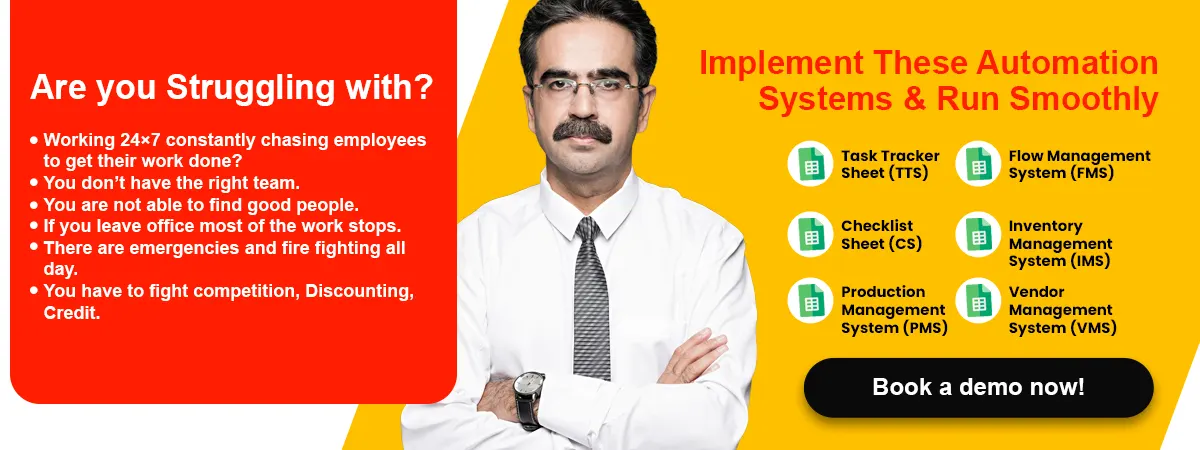by Soumyajit Admin
Share

In today’s fast-paced business world, staying competitive and efficient is paramount for long-term success. One proven strategy for achieving this is Business Process Reengineering (BPR). BPR isn’t just about minor tweaks or improvements; it is about a radical transformation of how a business operates.
But where do you begin? What are the 4 steps of business process reengineering that can lead to substantial improvements and innovation within your organization?
In this comprehensive guide, we will delve deep into the four essential steps of Business Process Reengineering, providing you with the knowledge and insights to revolutionize your company’s processes, boost productivity, and ultimately, enhance your bottom line. By the end of this article, you’ll have a clear understanding of how BPR can be a game-changer for your business.
Steps of Business Process Reengineering
Let’s keep reading.
Step 1: Understanding Current Processes
Before embarking on any journey of transformation, it is crucial to understand where you currently stand. The first step in Business Process Reengineering is to comprehensively analyze and document your existing processes. This involves identifying every aspect of your current workflow, from start to finish.
Begin by gathering input from various stakeholders, including employees, managers, and customers, if applicable. Document all the steps involved in your current processes, including any bottlenecks, redundancies, or inefficiencies.
This step is crucial because it allows you to identify areas that are ripe for improvement. By gaining a clear picture of your current state, you can prioritize which processes to reengineer first based on their impact on the organization’s overall goals.
Remember, the goal is not merely to automate existing processes but to rethink and redesign them from the ground up. This may require breaking down silos within the organization, as well as challenging long-held assumptions about how things should be done.
Also read: What Does Business Process Reengineering Involve?
Step 2: Redesigning Processes
Once you have a thorough understanding of your current processes, the next step in Business Process Reengineering is to redesign them. This is where creativity and innovation come into play. The goal here is to eliminate unnecessary steps, streamline workflows, and leverage technology to optimize processes for efficiency and effectiveness.
Start by questioning the fundamental aspects of each process. Ask yourself and your team: “Why do we do things this way? Can we achieve the same results more efficiently? Are there new technologies or tools that can help us streamline these processes?”
In the redesign phase, it is essential to involve key stakeholders and subject matter experts. Collaboration is key to ensuring that the proposed changes align with the organization’s strategic objectives and that they consider the perspectives of those who will be directly impacted.
It’s also crucial to think about the end-to-end process, considering how different steps interact with each other and how changes in one area might affect others. The goal is to create a seamless, efficient, and customer-centric process that adds value at every stage.
Step 3: Implementing Changes
Once the new processes are designed and approved, the next critical step is their implementation. This phase involves putting the re-engineered processes into action and ensuring that all employees are prepared for the changes.
Communication is paramount during this phase. Employees need to understand why the changes are happening, what they entail, and how they will impact their roles. Effective change management involves training, documentation, and ongoing support to help employees adapt to the new way of working.
It is also essential to monitor and measure the performance of the newly implemented processes. Key performance indicators (KPIs) should be established to track progress and identify any issues that may arise. Regular feedback from employees and customers should be collected and used to make necessary adjustments.
During the implementation phase, technology often plays a significant role. New tools, software, or automation solutions may be introduced to support the reengineered processes. Proper integration and testing are critical to ensuring that these technologies work seamlessly within the organization’s ecosystem.
Also read: When Should Business Process Reengineering Be Used
Step 4: Continuous Improvement
The final step in Business Process Reengineering is ongoing and continuous improvement. BPR is not a one-time project; it’s a mindset and a commitment to continually seek ways to enhance processes and stay competitive.
Regularly review the performance metrics and gather feedback from employees and customers. Identify areas where further optimization is possible and prioritize them based on their potential impact. This could involve fine-tuning existing processes, exploring new technologies, or adapting to changing market conditions.
Embracing a culture of continuous improvement is essential to the long-term success of your organization. It encourages innovation and ensures that your processes remain agile and adaptable in a rapidly changing business environment.
Navigating Business Process Reengineering Successfully: Tips, Pitfalls, and Leadership
Business Process Reengineering (BPR) is a powerful strategy for revitalizing your organization’s operations. However, its success hinges on a combination of practical tips, the avoidance of common pitfalls, and effective leadership and communication. In this article, we will delve into these critical aspects of BPR implementation, helping you maximize its benefits while minimizing disruption and challenges along the way.
Also read: What Is Business Process Reengineering?
Practical Tips for Effective BPR Implementation
-
Start with a Clear Vision:
Successful BPR begins with a well-defined vision of the desired outcomes. Ensure that your team understands the objectives, the expected benefits, and how the changes align with your organization’s strategic goals.
-
Engage Key Stakeholders:
Involve employees, managers, and other stakeholders in the process from the beginning. Their insights are invaluable for identifying inefficiencies and gaining buy-in for the changes.
-
Assemble a Competent Team:
Form a dedicated BPR team with diverse skills, including process analysts, IT experts, and change management professionals. This team will drive the BPR effort and ensure all aspects are considered.
-
Thoroughly Analyze Existing Processes:
Dive deep into your current processes to identify bottlenecks, redundancies, and areas for improvement. Tools like process mapping and value stream analysis can be invaluable in this phase.
-
Set Realistic Goals and Milestones:
Establish clear, measurable objectives and milestones for your BPR initiative. These provide a roadmap for progress and enable you to track your success effectively.
-
Prioritize Changes:
Not all processes require the same level of attention. Prioritize which processes to re-engineer based on their impact on the organization and alignment with your goals.
-
Embrace Technology Wisely:
Leverage technology and automation to streamline processes, but do so judiciously. Ensure that technology aligns with your goals and doesn’t introduce unnecessary complexity.
Also read: What Is Business Process Reengineering In ERP?
Common Pitfalls to Avoid During the Business Process Reengineering
-
Neglecting Change Management:
One of the most common pitfalls is underestimating the importance of change management. Failing to address employee concerns and resistance can derail even the most well-planned BPR effort.
-
Overlooking Cultural Shifts:
Organizational culture plays a significant role in BPR’s success. Ignoring cultural factors can lead to clashes between the old and new ways of working, hindering progress.
-
Inadequate Data and Analysis:
BPR relies heavily on data-driven decisions. Skipping comprehensive data collection and analysis can result in ill-informed process redesigns.
-
Rushing the Process:
BPR is not a quick fix; it requires careful planning and execution. Rushing through steps can lead to mistakes and incomplete implementations.
-
Focusing Solely on Cost-Cutting:
While cost reduction is often a primary goal, solely focusing on it can lead to neglecting other critical factors like quality, customer satisfaction, and long-term sustainability.
-
Failure to Monitor and Adjust:
BPR should be an iterative process. Failing to monitor and adjust post-implementation can cause issues to resurface and hinder long-term success.
The Role of Leadership and Communication in BPR Success
Leadership and communication are linchpins of successful BPR implementation:
- Visionary Leadership: Effective leaders provide a clear vision, champion the BPR initiative, and inspire the team to embrace change.
- Change Management: Leaders must address resistance to change by fostering a culture of adaptability, empathy, and continuous learning.
- Effective Communication: Open and transparent communication channels are essential. Leaders should share progress, address concerns, and celebrate successes to keep the team motivated.
- Cross-Functional Collaboration: Leadership should encourage collaboration across departments and ensure everyone understands their role in the BPR process.
- Adaptability: Leaders should be adaptable, ready to pivot as needed, and encourage innovation throughout the BPR journey.
NOTE:
In today’s fast-changing business world, companies always look for ways to work smarter, save money, and stay ahead. Business Process Reengineering (BPR) is a key strategy for this. At ECONSTRA, a top business consultancy focusing on automation solutions, we follow a simple four-step plan for BPR that gets results without causing disruption. First, we study current processes thoroughly to find areas where things can be done better. Then, we create new, more efficient processes using the latest technology and tools we offer. After that, we carefully put these new processes into action, making sure everyone understands the changes. Finally, we keep an eye on how things are going and make tweaks if needed. With ECONSTRA’s four-step plan, businesses can boost productivity and stay competitive in today’s fast-paced market.
Conclusion: Steps of Business Process Reengineering
In conclusion, the 4 steps of Business Process Reengineering are a proven method for organizations looking to thrive in today’s competitive landscape. By understanding your current processes, redesigning them for efficiency, implementing changes effectively, and committing to continuous improvement, you can transform your business for the better.
Business Process Reengineering is not a quick fix, but a strategic approach that can yield significant results over time. It requires a willingness to challenge the status quo, embrace change, and leverage technology to drive innovation.
So, if you have been wondering, “What are the 4 steps of business process reengineering?” now you have the answers. It’s time to take action and embark on the journey of reengineering your business processes to unlock new levels of efficiency, productivity, and success. Don’t wait; start your transformation today!
STAY IN THE LOOP
Subscribe to our free newsletter.
In today’s competitive business landscape, companies are constantly seeking ways to reduce operational costs while maintaining or improving efficiency and customer satisfaction. Customer Relationship Management (CRM) systems have emerged as vital tools that enable businesses to achieve these goals. As a leading business consultancy, Econstra understands the importance of leveraging CRM technology to streamline operations, […]
Why Operational Costs Are Draining Your Profits? Operational costs are a critical aspect of running a successful business, but when not managed properly, they can drain your profits and stifle growth. In a competitive market, maintaining profitability requires keen oversight of expenses and strategic planning. Econstra, as a leading business consultancy, provides insights and strategies […]
In the rapidly advancing digital landscape, Artificial Intelligence (AI) tools have emerged as transformative assets for businesses. Their potential to enhance efficiency, streamline operations, and drive innovation makes them invaluable for business consultants and organizations worldwide. For business consultants in India, AI’s strategic application can be particularly advantageous in navigating a diverse and dynamic market. […]
In today’s competitive business landscape, marketing is more crucial than ever. Companies are constantly seeking innovative strategies to stay ahead of the curve. Yet, navigating the complexities of modern marketing requires more than just creativity; it demands expertise and strategic insight. This is where a Business Consultant can make a transformative impact. Business consultants offer […]





